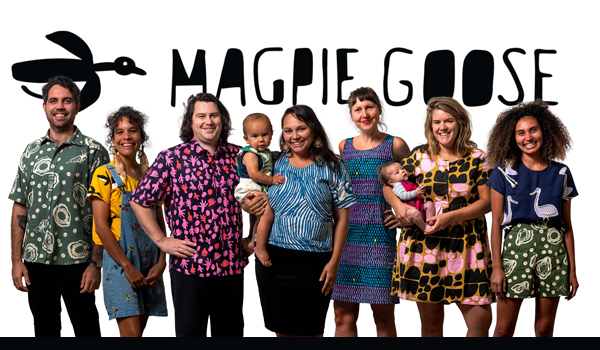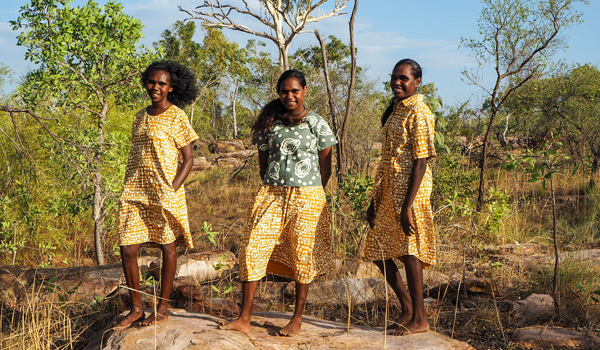Magpie Goose transitions to Aboriginal Ownership
June 9, 2021
Magpie Goose is a social enterprise founded by Maggie McGowan and Laura Egan. The brand launched back in 2015, and since then they have collaborated with First Nations artists to produce collections with artwork printed onto sustainable fabrics. It is their vision for artists to share their unique Australian stories and culture through the medium of fashion, and to create employment opportunities for First Nations people in all aspects of the fashion industry.
Their goal of transitioning to Aboriginal ownership has now come to fruition, as Brisbane entrepreneurs Troy Casey; a proud Kamilaroi man, and his partner Amanda Hayman; proud Wakka Wakka and Kalkadoon woman took the reins back in March. We spoke to Troy for some insight on their ambitions for the brand’s future.

How did you come to know the brand through its original owners, did you come across one another naturally, both working in creative industries?
“Yes, working in any kind of creative industry (especially Aboriginal art and design) you get to know who’s who and doing what very quickly. We established a relationship with Maggie and Laura through our retail space called Open House, where we stocked their products.
We had always appreciated what they’d done and so connecting with them personally and understanding their aspirations for the business, we saw they were well aligned with our ethics and morals. It was a really nice fit and that led to a level of trust for them to come and approach us around taking over leadership and ownership as Aboriginal business owners.”
What has the adjusting period been like, have you faced any challenges?
“I’ll be honest, it’s been really challenging. I think any company doing anything ethically; it adds a level of difficulty to the operations of the business. Not only is it being run ethically, but all within Australia. So, it is a high cost business, and there are a bunch of moving parts.
The last couple of months have been an adjustment to understand all those factors and how we can refine them and deliver them the best we possibly can, bearing in mind that the whole purpose of this business is to support Aboriginal and Torres Strait Islander artists and designers that work in remote communities. It’s been hard, with the work we are putting in, but the flow on effects are really important!
I think there has been this interesting rise in conscious consumers and people wanting to buy ethically, and locally. Our business is doing all those things whilst supporting our community members at the same time through economic opportunities. The brand speaks for itself in terms of what it does and its impact.”
Where do you see Magpie Goose in five years?
“I’ve got big dreams! I think a lot of people know Magpie Goose in this country already, we have a very loyal customer base. There is still plenty of room to grow in Australia, and I would see that within 5 years we’d have a series of flagship stores around the country where people can come and try on Magpie Goose all year round. At the moment we are predominantly an online business that runs a series of pop-up stores per year at art fairs or independently.
I think that these products tell a very particular story about our country and our community and that’s a story I’d like to take to the world. People in our own backyard are only slowly starting to appreciate Aboriginal culture, but global audiences are hungry to learn more about who we are as Aboriginal people, and I hope that this brand is a connection point for them to do so in the international market.
This brand also has an opportunity to become an iconic Australian brand like R.M. Williams, or Akubra etc. When people think of Australian brands and fashion I want them to think of Magpie Goose. At the end of the day what that means is the bottom line for the artists we are supporting becomes bigger. In our hearts and at the core of our business is the impact we can create by growing the business as well”

It’s so great that Magpie Goose is now an Aboriginal owned and led business. How important is it to you to provide opportunities to First Nations people in your business?
“I think it’s important to ask what other opportunities can we provide outside of just the artists that we service as part of the fashion label. It’s not just about entry level employment opportunities. We are figuring out how we can upskill others inside the organisation to higher management roles.”
Ideally at some point we’d like to say we are 100% owned and operated. Now while we are learning and understanding the industry, that is a long-term goal. We need to find experts in the industry that can train and upskill Aboriginal people to do those jobs. We are in the process of considering an Indigenous employment strategy and how it will look moving forward for the business.”
How do you source design materials?
“The way the business operated previously was they would pick art centres and go out and work with those art centres or community organisations. It transitioned to a point of not having to identify people, and people approaching us to want to collaborate with Magpie Goose.
Now under Aboriginal Ownership we want to stay true to what the brand has done previously, but also provide opportunities on a more national footprint – previously it has been mostly Top End communities they’ve worked with. But there are so many amazing Aboriginal artists across the country that would equally be as great to work with. It’s also trying to find a balance of identifying artists and art centres we would really love to collaborate with, and working with other groups that are also really passionate about telling their stories through Magpie Goose.”
What are your thoughts on the licensing process within the company?
“One of the things that we were interested in when we took this company on was ensuring that the licensing agreements and the contract with the artists are of utmost importance to us. We want to make sure that artists are being paid the most that they can be paid, all the while ensuring we can keep doing what we are doing as a sustainable business model.
Because Indigenous fashion is a relatively new industry, there is no industry standard, no guide book or rule book around price per metre, licensing or pay rates, etc.
It is really great to have an organisation like Copyright Agency who not only understands licensing agreements, but with Arlette (Copyright Agency’s Visual Arts Business Development Manager) understanding the fashion industry inside and out, she is able to ensure that artists are being paid as much as they can, as well as factoring in that we are a small fashion label that needs to keep making clothes – otherwise we don’t get to support more artists in the future, so working with an organisation like Copyright Agency is priceless for us.“

What is the rest of the year looking like for you, do you have any exciting plans in store?
“We have a series of events lined up. Our application has been successful to be part of Darwin Art Fair’s fashion show ‘Country Couture’ – on the runway as well as a pop up store, and Cairns Indigenous Art fair. A few trips out to communities and a series of other pop-up stores later in the year.
We are working closely with our production manager and manufacturer to streamline processes so we can get more fashion out to the people that love our brand.
Another critical part is Amanda and I really getting to know this business and this brand so we can continue to support our communities. The stories that we are hearing coming out of the artists that we support are so touching, and this is exactly the reason why we do what we do for our community, and for those who don’t have as many opportunities as some of the others, it’s an amazing brand and we can’t wait to keep growing the business into the future in Aboriginal hands.”
See Magpie Goose on the runway or visit their pop up stores at Darwin Art Fair from August 5-22, and Cairns Indigenous Art Fair between August 17-22, or browse the stunning collections on their website here.

